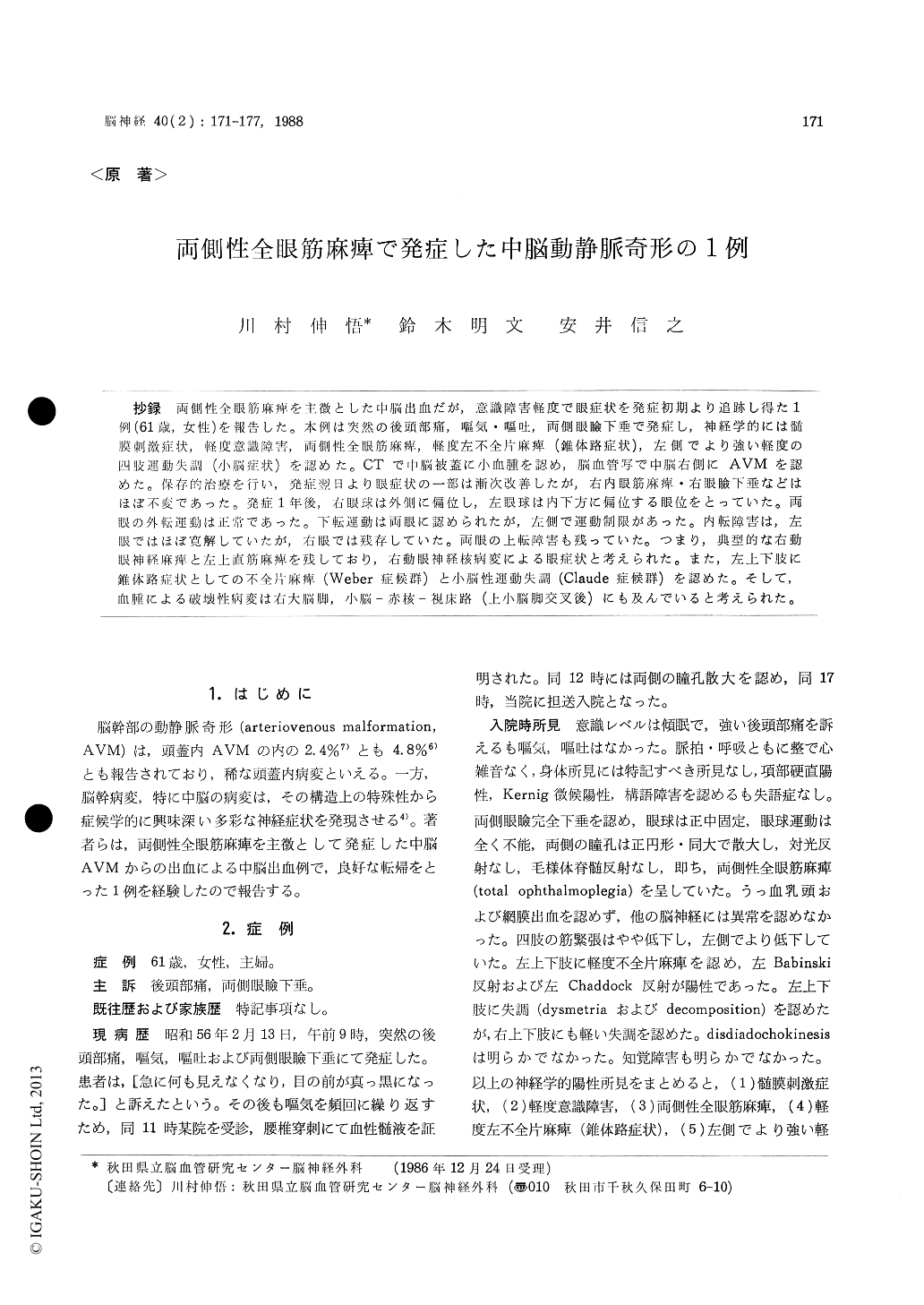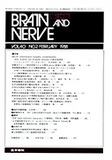Japanese
English
- 有料閲覧
- Abstract 文献概要
- 1ページ目 Look Inside
抄録 両側性全眼筋麻痺を主徴とした中脳出血だが,意識障害軽度で眼症状を発症初期より追跡し得た1例(61歳,女性)を報告した。本例は突然の後頭部痛,嘔気・嘔吐,両側眼瞼下垂で発症し,神経学的には髄膜刺激症状,軽度意識障害,両側性全眼筋麻痺,軽度左不全片麻痺(錐体路症状),左側でより強い軽度の四肢運動失調(小脳症状)を認めた。CTで中脳被蓋に小血腫を認め,脳血管写で中脳右側にAVMを認めた。保存的治療を行い,発症翌日より眼症状の一部は漸次改善したが,右内眼筋麻痺・右眼瞼下垂などはほぼ不変であった。発症1年後,右眼球は外側に偏位し,左眼球は内下方に偏位する眼位をとっていた。両眼の外転運動は正常であった。下転運動は両眼に認められたが,左側で運動制限があった。内転障害は,左眼ではほぼ寛解していたが,右眼では残存していた。両眼の上転障害も残っていた。つまり,典型的な右動眼神経麻痺と左上直筋麻痺を残しており,右動眼神経核病変による眼症状と考えられた。また,左上下肢に錐体路症状としての不全片麻痺(Weber症候群)と小脳性運動失調(Claude症候群)を認めた。そして,血腫による破壊性病変は右大脳脚,小脳—赤核—視床路(上小脳脚交叉後)にも及んでいると考えられた。
A 61-year-old woman is presented with a bi-lateral total ophthalmoplegia as an initial ocular symptom, caused by a midbrain hematoma. She complained of acute headache, nausea, vomiting and bilateral closure of her eyelids. Examination on admission showed meningeal irritation ; mild consciousness disturbance ; bilateral total ophthal-moplegia ; left hemiparesis ; ataxia in all extremi-ties, more marked to the left. Computed tomogra-phy demonstrated a small hematoma in the mid-brain tegmentum. Angiography demonstrated mid-brain arteriovenous malformation, and she was treated conservatively. Abduction of both eyes and adduction of the left eye appeared on the next day of the ictus, and after that, improvedgradually. Left ptosis had improved since one week after the ictus. Light reflex of the left pupil had seen 5 days after the ictus. At the same time, the left pupil revealed an oval-shape. Right internal ophthalmoplegia continued to exist. One year later, the right eye deviated externally, and the left deviated inferio-medially. Abduction of both eyes was normal. Infraduction of both eyes was seen, but limited on the left. Upgaze paresis remained unchanged, and adduction of the right eye was absent. Adduction of the left eye showed almost full recovery. There was right complete ptosis, but left ptosis became indefinite. These ocular findings indicated typical right ocu-lomotor paresis plus superior rectus paresis of the left eye, which suggested a destructive lesion in the right oculomotor nucleus. Also, her left extremities showed a hemiparesis as a pyramidal tract sign (Weber's syndrome) and an ataxia as a cerebellar sign (Claude's syndrome). Thus, the lesion seemed to extend into both the right cere-bral peduncle and the cerebellorubrothalamic tract after the decussation of the superior cerebellar peduncle. Now, she has an useful daily living with no assistance 5.7 years after the ictus.

Copyright © 1988, Igaku-Shoin Ltd. All rights reserved.


